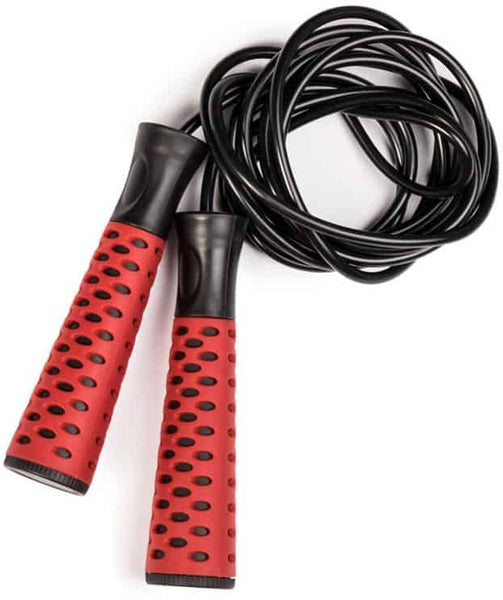Your Cart is Empty
March 23, 2024 4 min read
If you’re looking to achieve the classic bodybuilder physique, then having well-developed calves is a must. Calves are one of those muscle groups that really stands out and adds to your overall aesthetic. But developing calves can be quite challenging, so if you’re not sure how to go about it, then this article is for you.
Shop The Collection: RopesIn this article, we’ll discuss some secrets to developing your calf muscles with free weights. We’ll explore the importance of using proper form, progressive overload, and choosing the right exercises to maximize your gains. We’ll also look at how to incorporate calf training into your routine, as well as provide some tips for avoiding common mistakes.
 Shop The Gear: COREFX Speed Rope, $13.99 USD
Shop The Gear: COREFX Speed Rope, $13.99 USD
The first secret to developing your calves with free weights is to use proper form. When it comes to free weight exercises, form is essential. If you don’t use the correct technique, then you won’t be able to work the muscles effectively and could even end up injured.
Shop The Collection: Resistance BandsWhen performing calf exercises, it’s important to keep your back straight, your head up, and your core engaged. You should also keep your range of motion relatively small and focus on squeezing your calves at the top of the movement. This will help ensure that you’re targeting the right muscles and getting the most out of your workout.
 Shop The Gear: MAGMA 5-Pack Resistance Bands Bundle With Bag, $77.99 USD
Shop The Gear: MAGMA 5-Pack Resistance Bands Bundle With Bag, $77.99 USD
Another secret to developing your calves with free weights is to utilize progressive overload. Progressive overload is a concept that involves gradually increasing the intensity of your workouts over time in order to stimulate muscle growth. Essentially, you want to consistently challenge your muscles by progressively adding more weight or reps to your exercises.
For example, if you start with 10 reps of a certain exercise, then you can gradually increase the reps to 12, 15, or even 20 as your muscles get stronger. This will force your muscles to adapt and grow in order to handle the increased workload.
In addition to using proper form and progressive overload, you also need to choose the right exercises. Different exercises target different muscles, so you want to make sure you’re doing exercises that are specifically designed to work the calf muscles. Some of the best calf exercises with free weights include standing calf raises, donkey calf raises, and calf press.
Standing calf raises involve holding a weight in each hand and standing on a step or platform. You then lower your heels as low as possible and raise them as high as you can. Donkey calf raises involve kneeling on the floor and placing your hands on a wall for support. You then lift your heels as high as you can and lower them back down.
Finally, calf presses involve placing a weight plate between your ankles and pushing outward against it. This exercise helps strengthen the entire calf complex, including the gastrocnemius and soleus muscles. All three of these exercises can be done with free weights, and they’re a great way to develop your calves.
When it comes to calf training, frequency and intensity are key. You want to train your calves at least twice per week if you’re looking to make progress. As far as intensity goes, it’s important to push yourself to the point of momentary muscular failure. This will ensure that you’re stimulating the muscles enough to cause growth.
It’s also important to give your muscles enough time to recover. Calf muscles are very small and fast-twitch, so they need extra rest in order to heal and grow. Aim for at least 48 hours of rest between calf workouts to allow the muscles to recover properly.
Finally, there are some common mistakes to avoid when training your calves with free weights. First, make sure to use a full range of motion for all exercises. Don’t cut the range of motion short, as this won’t allow the muscles to get the full benefit of the exercise.
Second, don’t use momentum when lifting. Momentum is when you use your body weight or swing the weight to generate force. This doesn’t allow the target muscles to do the work, and it increases the risk of injury. Finally, don’t forget to stretch after your workouts. Stretching helps reduce muscle soreness, improve flexibility, and promote recovery.
Developing your calves with free weights is a great way to add size and strength to your legs. By following the secrets outlined in this article, you can maximize your results and achieve the physique you desire. Just remember to use proper form, incorporate progressive overload, and choose the right exercises in order to get the most out of your workouts.
Finally, don’t forget to give your muscles enough time to rest and recover. With a bit of patience and dedication, you’ll be well on your way to developing impressive calves.
Shipping Protection gives you peace of mind while saving you time and money.
Shipping Protection provides coverage for eligible orders that are lost or damaged in transit, or stolen after delivery has been confirmed by the carrier. MAGMA Fitness, through its partners, administers the protection program and may receive compensation for these services. Coverage is subject to the terms, conditions, and exclusions outlined in our Shipping Protection Terms & Conditions.